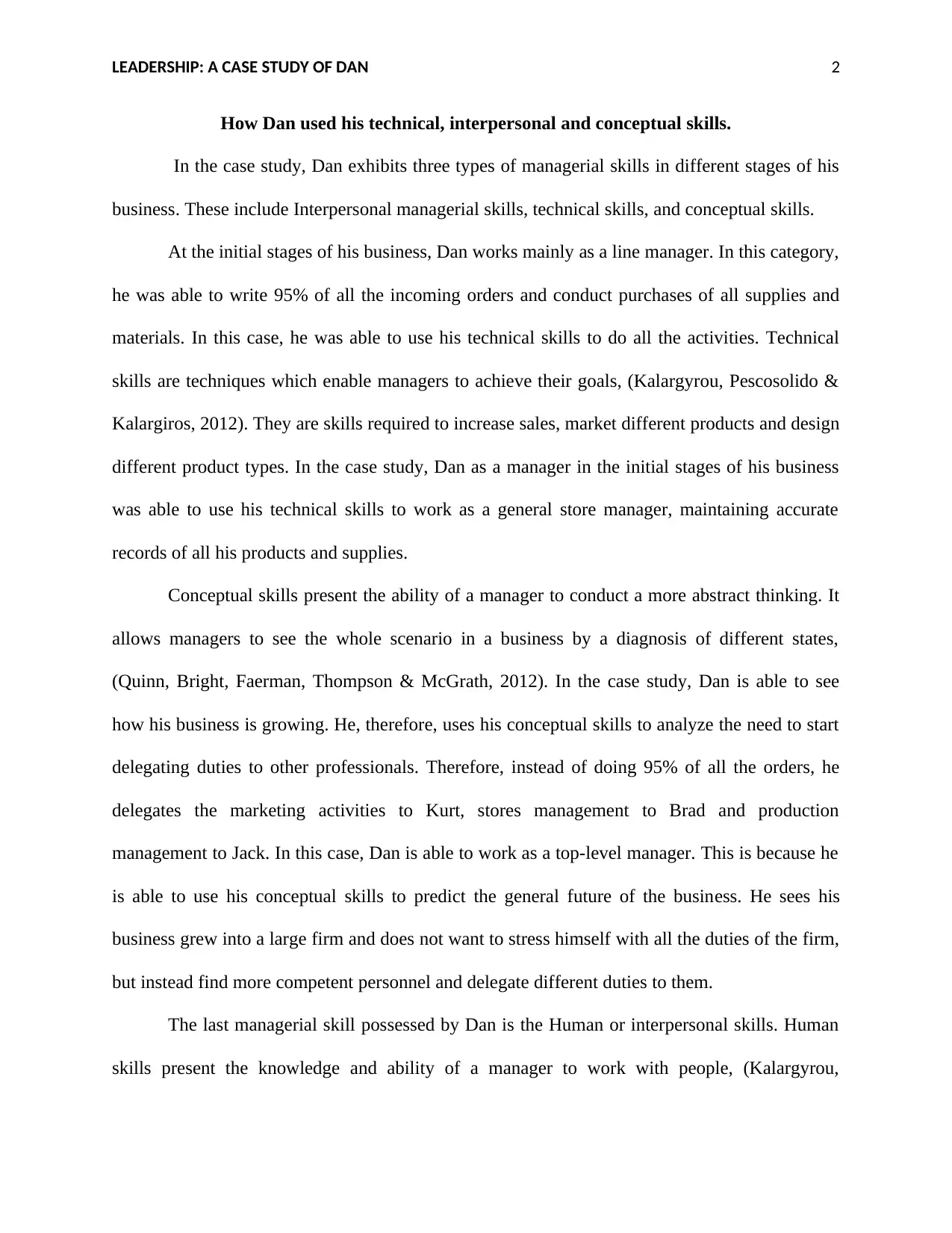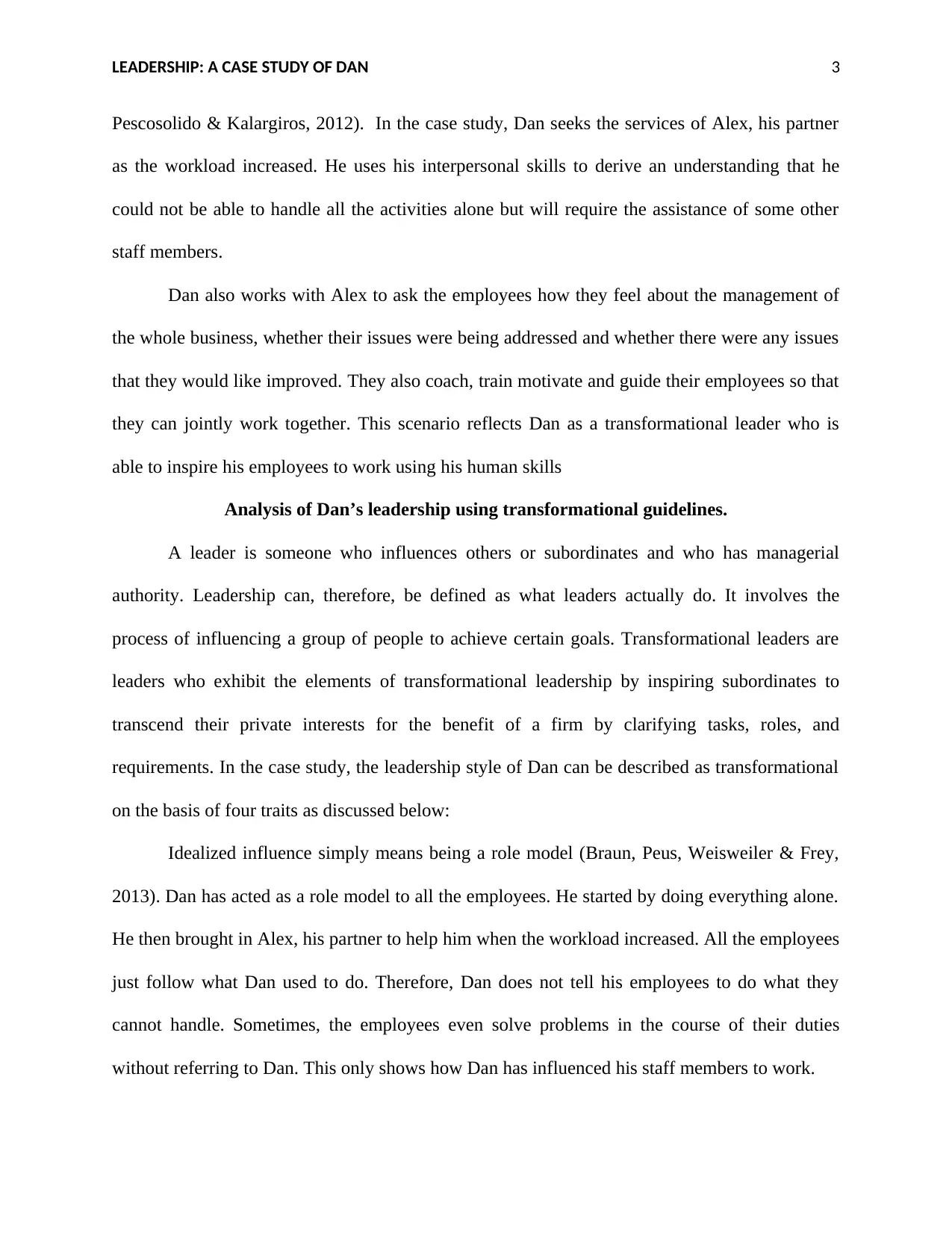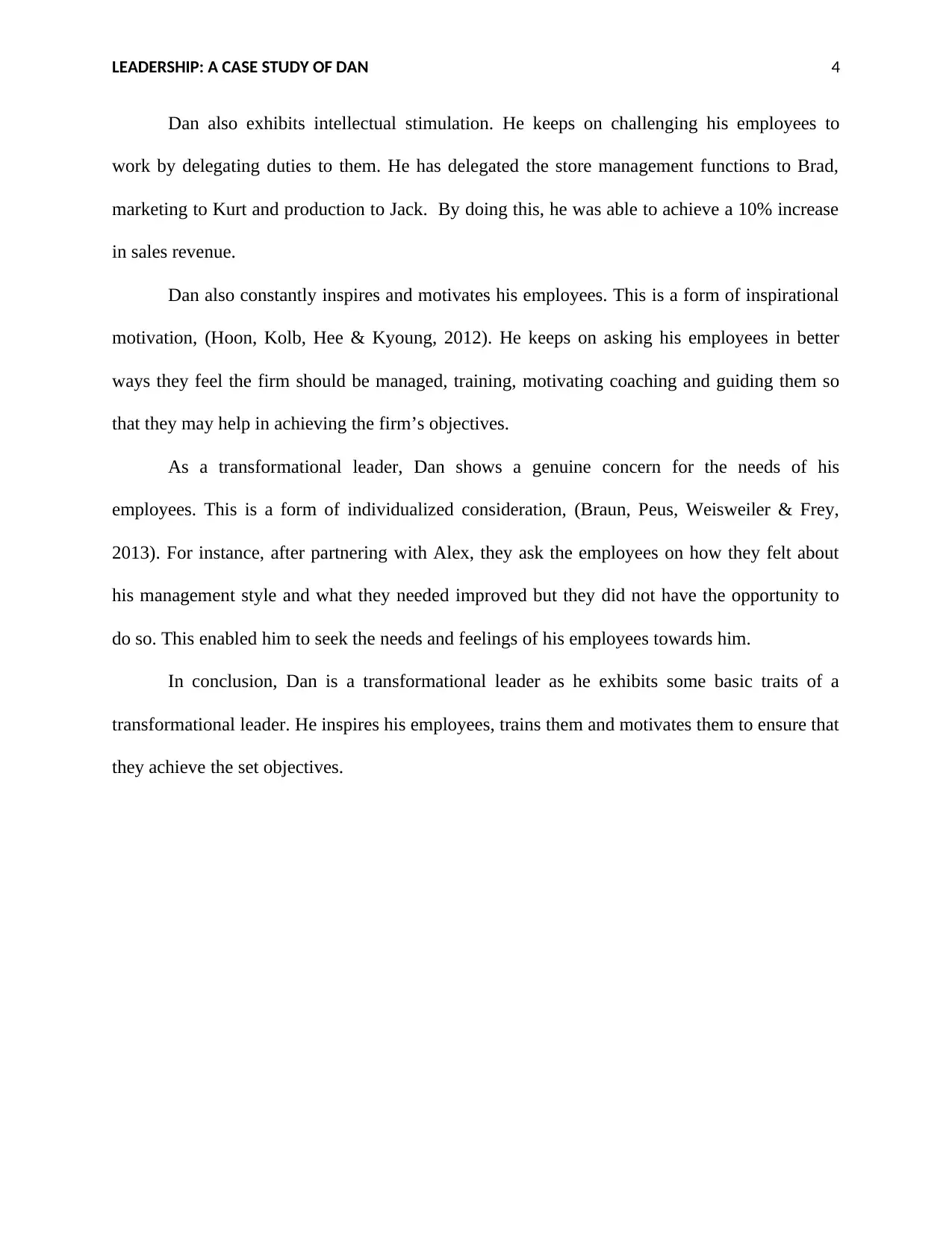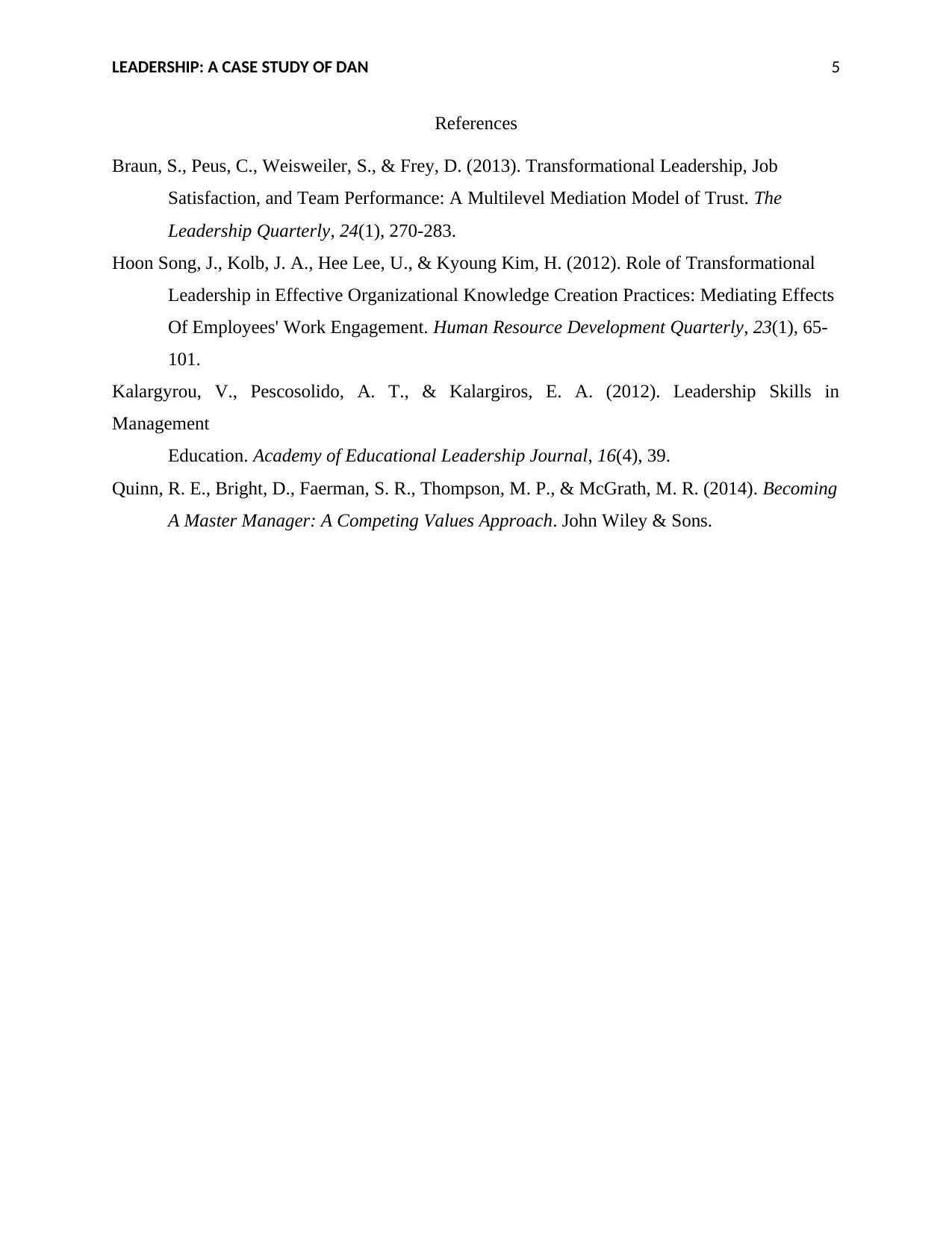Leadership Case Study: Transformational Leadership of Dan
VerifiedAdded on 2023/06/16
|5
|1244
|276
Case Study
AI Summary
This case study analyzes Dan's leadership approach, highlighting his evolution from a hands-on manager to a transformational leader. Initially, Dan relied heavily on his technical skills, managing most of the business operations himself. As the company grew, he recognized the need to delegate and developed his conceptual and interpersonal skills. He brought in a partner, Alex, and together they sought employee feedback, implemented training programs, and fostered a more collaborative environment. Dan's leadership style is characterized by idealized influence, intellectual stimulation, inspirational motivation, and individualized consideration. By delegating tasks to competent personnel like Brad, Kurt, and Jack, Dan not only reduced his workload but also empowered his employees, leading to increased sales revenue and overall business success. The analysis concludes that Dan exhibits key traits of a transformational leader, effectively inspiring, training, and motivating his team to achieve organizational goals.

Running head: LEADERSHIP: A CASE STUDY OF DAN 1
LEADERSHIP: A CASE STUDY OF DAN
Student
Institution
Professor
LEADERSHIP: A CASE STUDY OF DAN
Student
Institution
Professor
Paraphrase This Document
Need a fresh take? Get an instant paraphrase of this document with our AI Paraphraser

LEADERSHIP: A CASE STUDY OF DAN 2
How Dan used his technical, interpersonal and conceptual skills.
In the case study, Dan exhibits three types of managerial skills in different stages of his
business. These include Interpersonal managerial skills, technical skills, and conceptual skills.
At the initial stages of his business, Dan works mainly as a line manager. In this category,
he was able to write 95% of all the incoming orders and conduct purchases of all supplies and
materials. In this case, he was able to use his technical skills to do all the activities. Technical
skills are techniques which enable managers to achieve their goals, (Kalargyrou, Pescosolido &
Kalargiros, 2012). They are skills required to increase sales, market different products and design
different product types. In the case study, Dan as a manager in the initial stages of his business
was able to use his technical skills to work as a general store manager, maintaining accurate
records of all his products and supplies.
Conceptual skills present the ability of a manager to conduct a more abstract thinking. It
allows managers to see the whole scenario in a business by a diagnosis of different states,
(Quinn, Bright, Faerman, Thompson & McGrath, 2012). In the case study, Dan is able to see
how his business is growing. He, therefore, uses his conceptual skills to analyze the need to start
delegating duties to other professionals. Therefore, instead of doing 95% of all the orders, he
delegates the marketing activities to Kurt, stores management to Brad and production
management to Jack. In this case, Dan is able to work as a top-level manager. This is because he
is able to use his conceptual skills to predict the general future of the business. He sees his
business grew into a large firm and does not want to stress himself with all the duties of the firm,
but instead find more competent personnel and delegate different duties to them.
The last managerial skill possessed by Dan is the Human or interpersonal skills. Human
skills present the knowledge and ability of a manager to work with people, (Kalargyrou,
How Dan used his technical, interpersonal and conceptual skills.
In the case study, Dan exhibits three types of managerial skills in different stages of his
business. These include Interpersonal managerial skills, technical skills, and conceptual skills.
At the initial stages of his business, Dan works mainly as a line manager. In this category,
he was able to write 95% of all the incoming orders and conduct purchases of all supplies and
materials. In this case, he was able to use his technical skills to do all the activities. Technical
skills are techniques which enable managers to achieve their goals, (Kalargyrou, Pescosolido &
Kalargiros, 2012). They are skills required to increase sales, market different products and design
different product types. In the case study, Dan as a manager in the initial stages of his business
was able to use his technical skills to work as a general store manager, maintaining accurate
records of all his products and supplies.
Conceptual skills present the ability of a manager to conduct a more abstract thinking. It
allows managers to see the whole scenario in a business by a diagnosis of different states,
(Quinn, Bright, Faerman, Thompson & McGrath, 2012). In the case study, Dan is able to see
how his business is growing. He, therefore, uses his conceptual skills to analyze the need to start
delegating duties to other professionals. Therefore, instead of doing 95% of all the orders, he
delegates the marketing activities to Kurt, stores management to Brad and production
management to Jack. In this case, Dan is able to work as a top-level manager. This is because he
is able to use his conceptual skills to predict the general future of the business. He sees his
business grew into a large firm and does not want to stress himself with all the duties of the firm,
but instead find more competent personnel and delegate different duties to them.
The last managerial skill possessed by Dan is the Human or interpersonal skills. Human
skills present the knowledge and ability of a manager to work with people, (Kalargyrou,

LEADERSHIP: A CASE STUDY OF DAN 3
Pescosolido & Kalargiros, 2012). In the case study, Dan seeks the services of Alex, his partner
as the workload increased. He uses his interpersonal skills to derive an understanding that he
could not be able to handle all the activities alone but will require the assistance of some other
staff members.
Dan also works with Alex to ask the employees how they feel about the management of
the whole business, whether their issues were being addressed and whether there were any issues
that they would like improved. They also coach, train motivate and guide their employees so that
they can jointly work together. This scenario reflects Dan as a transformational leader who is
able to inspire his employees to work using his human skills
Analysis of Dan’s leadership using transformational guidelines.
A leader is someone who influences others or subordinates and who has managerial
authority. Leadership can, therefore, be defined as what leaders actually do. It involves the
process of influencing a group of people to achieve certain goals. Transformational leaders are
leaders who exhibit the elements of transformational leadership by inspiring subordinates to
transcend their private interests for the benefit of a firm by clarifying tasks, roles, and
requirements. In the case study, the leadership style of Dan can be described as transformational
on the basis of four traits as discussed below:
Idealized influence simply means being a role model (Braun, Peus, Weisweiler & Frey,
2013). Dan has acted as a role model to all the employees. He started by doing everything alone.
He then brought in Alex, his partner to help him when the workload increased. All the employees
just follow what Dan used to do. Therefore, Dan does not tell his employees to do what they
cannot handle. Sometimes, the employees even solve problems in the course of their duties
without referring to Dan. This only shows how Dan has influenced his staff members to work.
Pescosolido & Kalargiros, 2012). In the case study, Dan seeks the services of Alex, his partner
as the workload increased. He uses his interpersonal skills to derive an understanding that he
could not be able to handle all the activities alone but will require the assistance of some other
staff members.
Dan also works with Alex to ask the employees how they feel about the management of
the whole business, whether their issues were being addressed and whether there were any issues
that they would like improved. They also coach, train motivate and guide their employees so that
they can jointly work together. This scenario reflects Dan as a transformational leader who is
able to inspire his employees to work using his human skills
Analysis of Dan’s leadership using transformational guidelines.
A leader is someone who influences others or subordinates and who has managerial
authority. Leadership can, therefore, be defined as what leaders actually do. It involves the
process of influencing a group of people to achieve certain goals. Transformational leaders are
leaders who exhibit the elements of transformational leadership by inspiring subordinates to
transcend their private interests for the benefit of a firm by clarifying tasks, roles, and
requirements. In the case study, the leadership style of Dan can be described as transformational
on the basis of four traits as discussed below:
Idealized influence simply means being a role model (Braun, Peus, Weisweiler & Frey,
2013). Dan has acted as a role model to all the employees. He started by doing everything alone.
He then brought in Alex, his partner to help him when the workload increased. All the employees
just follow what Dan used to do. Therefore, Dan does not tell his employees to do what they
cannot handle. Sometimes, the employees even solve problems in the course of their duties
without referring to Dan. This only shows how Dan has influenced his staff members to work.
⊘ This is a preview!⊘
Do you want full access?
Subscribe today to unlock all pages.

Trusted by 1+ million students worldwide

LEADERSHIP: A CASE STUDY OF DAN 4
Dan also exhibits intellectual stimulation. He keeps on challenging his employees to
work by delegating duties to them. He has delegated the store management functions to Brad,
marketing to Kurt and production to Jack. By doing this, he was able to achieve a 10% increase
in sales revenue.
Dan also constantly inspires and motivates his employees. This is a form of inspirational
motivation, (Hoon, Kolb, Hee & Kyoung, 2012). He keeps on asking his employees in better
ways they feel the firm should be managed, training, motivating coaching and guiding them so
that they may help in achieving the firm’s objectives.
As a transformational leader, Dan shows a genuine concern for the needs of his
employees. This is a form of individualized consideration, (Braun, Peus, Weisweiler & Frey,
2013). For instance, after partnering with Alex, they ask the employees on how they felt about
his management style and what they needed improved but they did not have the opportunity to
do so. This enabled him to seek the needs and feelings of his employees towards him.
In conclusion, Dan is a transformational leader as he exhibits some basic traits of a
transformational leader. He inspires his employees, trains them and motivates them to ensure that
they achieve the set objectives.
Dan also exhibits intellectual stimulation. He keeps on challenging his employees to
work by delegating duties to them. He has delegated the store management functions to Brad,
marketing to Kurt and production to Jack. By doing this, he was able to achieve a 10% increase
in sales revenue.
Dan also constantly inspires and motivates his employees. This is a form of inspirational
motivation, (Hoon, Kolb, Hee & Kyoung, 2012). He keeps on asking his employees in better
ways they feel the firm should be managed, training, motivating coaching and guiding them so
that they may help in achieving the firm’s objectives.
As a transformational leader, Dan shows a genuine concern for the needs of his
employees. This is a form of individualized consideration, (Braun, Peus, Weisweiler & Frey,
2013). For instance, after partnering with Alex, they ask the employees on how they felt about
his management style and what they needed improved but they did not have the opportunity to
do so. This enabled him to seek the needs and feelings of his employees towards him.
In conclusion, Dan is a transformational leader as he exhibits some basic traits of a
transformational leader. He inspires his employees, trains them and motivates them to ensure that
they achieve the set objectives.
Paraphrase This Document
Need a fresh take? Get an instant paraphrase of this document with our AI Paraphraser

LEADERSHIP: A CASE STUDY OF DAN 5
References
Braun, S., Peus, C., Weisweiler, S., & Frey, D. (2013). Transformational Leadership, Job
Satisfaction, and Team Performance: A Multilevel Mediation Model of Trust. The
Leadership Quarterly, 24(1), 270-283.
Hoon Song, J., Kolb, J. A., Hee Lee, U., & Kyoung Kim, H. (2012). Role of Transformational
Leadership in Effective Organizational Knowledge Creation Practices: Mediating Effects
Of Employees' Work Engagement. Human Resource Development Quarterly, 23(1), 65-
101.
Kalargyrou, V., Pescosolido, A. T., & Kalargiros, E. A. (2012). Leadership Skills in
Management
Education. Academy of Educational Leadership Journal, 16(4), 39.
Quinn, R. E., Bright, D., Faerman, S. R., Thompson, M. P., & McGrath, M. R. (2014). Becoming
A Master Manager: A Competing Values Approach. John Wiley & Sons.
References
Braun, S., Peus, C., Weisweiler, S., & Frey, D. (2013). Transformational Leadership, Job
Satisfaction, and Team Performance: A Multilevel Mediation Model of Trust. The
Leadership Quarterly, 24(1), 270-283.
Hoon Song, J., Kolb, J. A., Hee Lee, U., & Kyoung Kim, H. (2012). Role of Transformational
Leadership in Effective Organizational Knowledge Creation Practices: Mediating Effects
Of Employees' Work Engagement. Human Resource Development Quarterly, 23(1), 65-
101.
Kalargyrou, V., Pescosolido, A. T., & Kalargiros, E. A. (2012). Leadership Skills in
Management
Education. Academy of Educational Leadership Journal, 16(4), 39.
Quinn, R. E., Bright, D., Faerman, S. R., Thompson, M. P., & McGrath, M. R. (2014). Becoming
A Master Manager: A Competing Values Approach. John Wiley & Sons.
1 out of 5
Related Documents
Your All-in-One AI-Powered Toolkit for Academic Success.
+13062052269
info@desklib.com
Available 24*7 on WhatsApp / Email
![[object Object]](/_next/static/media/star-bottom.7253800d.svg)
Unlock your academic potential
Copyright © 2020–2025 A2Z Services. All Rights Reserved. Developed and managed by ZUCOL.




